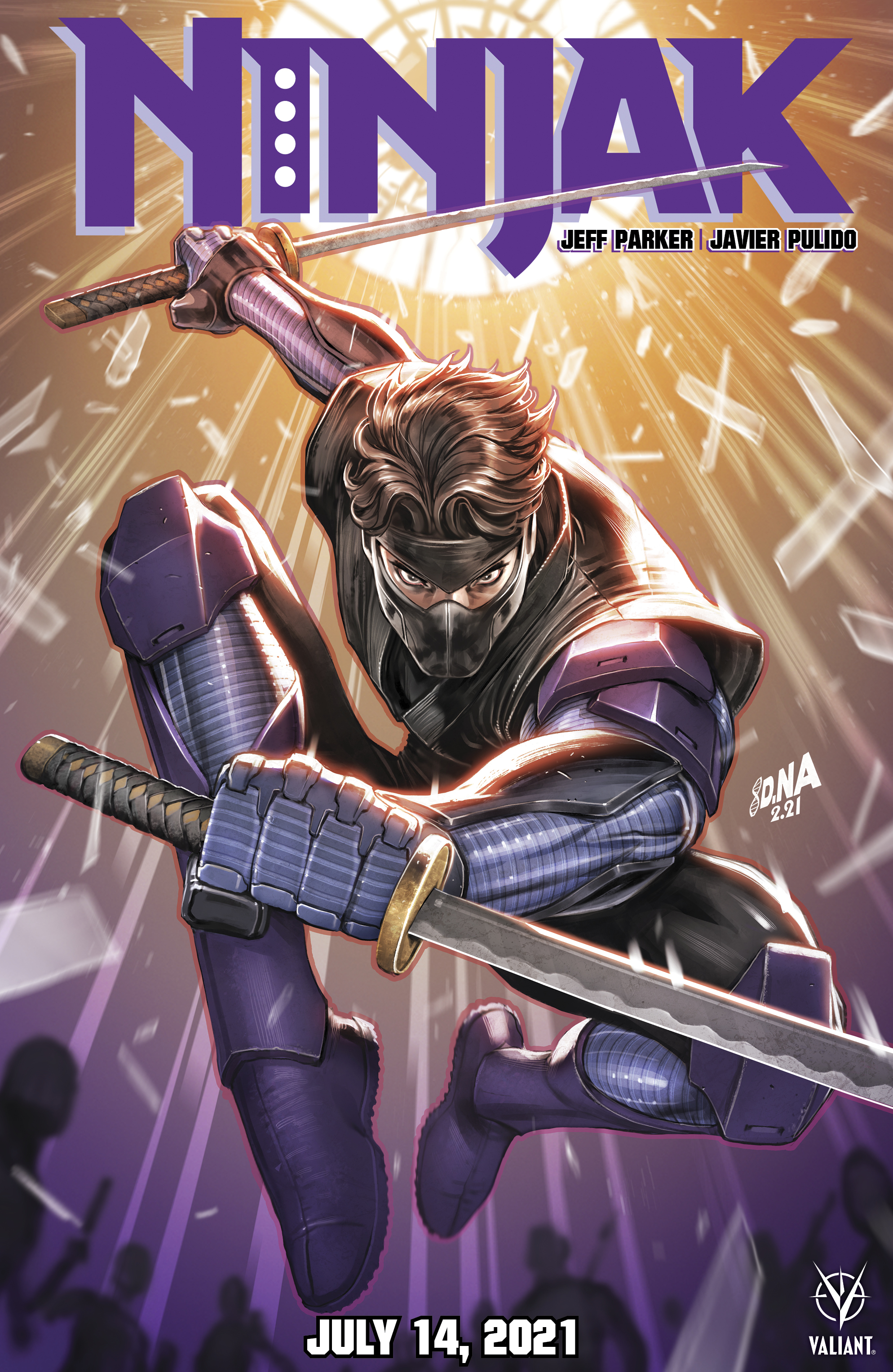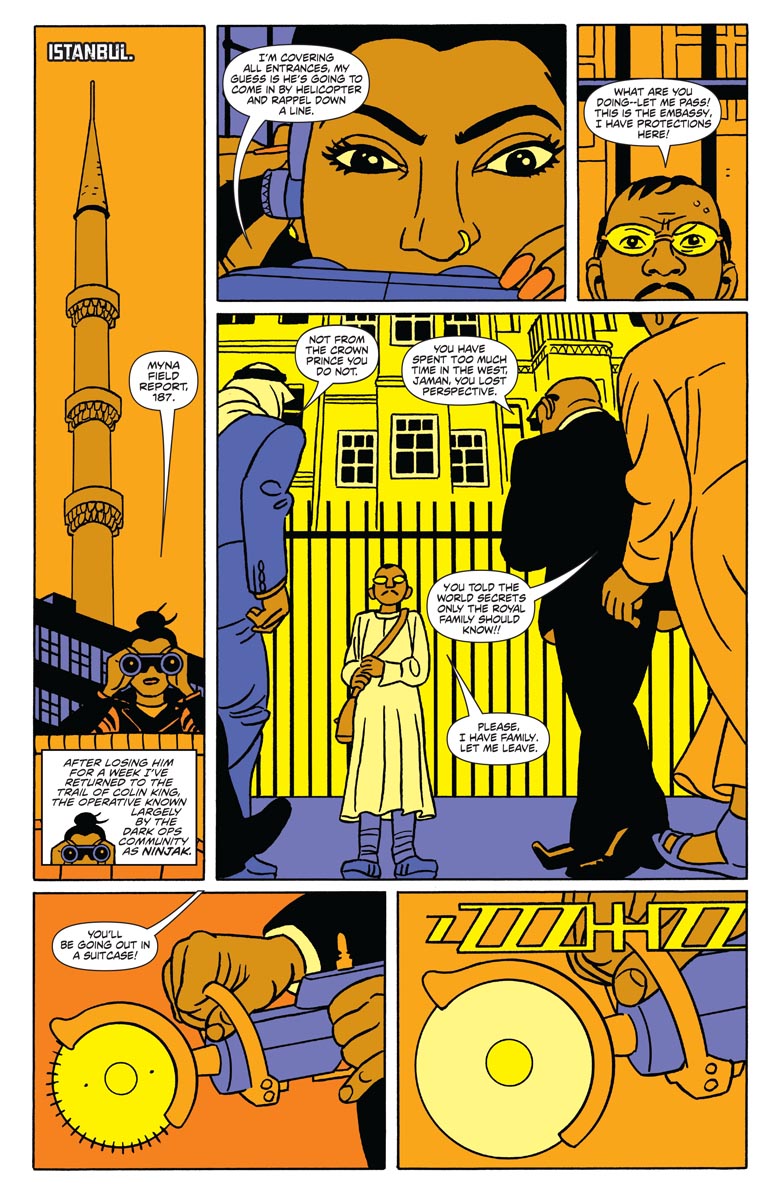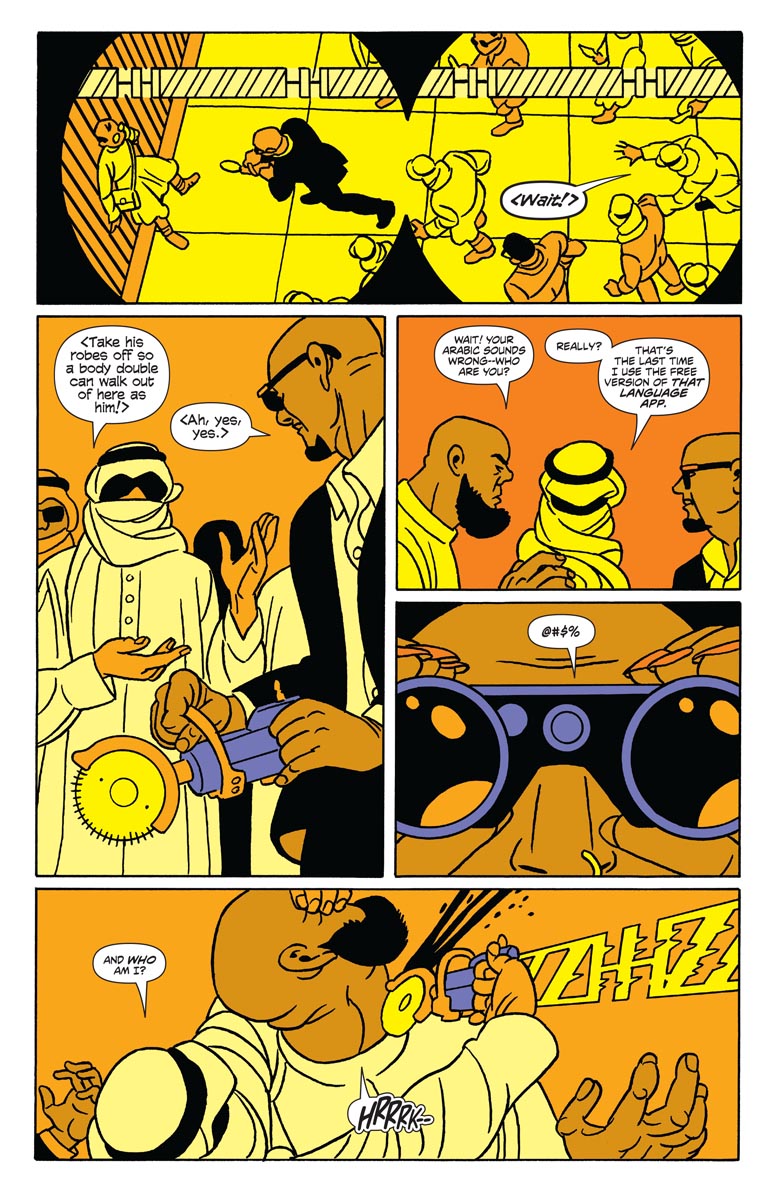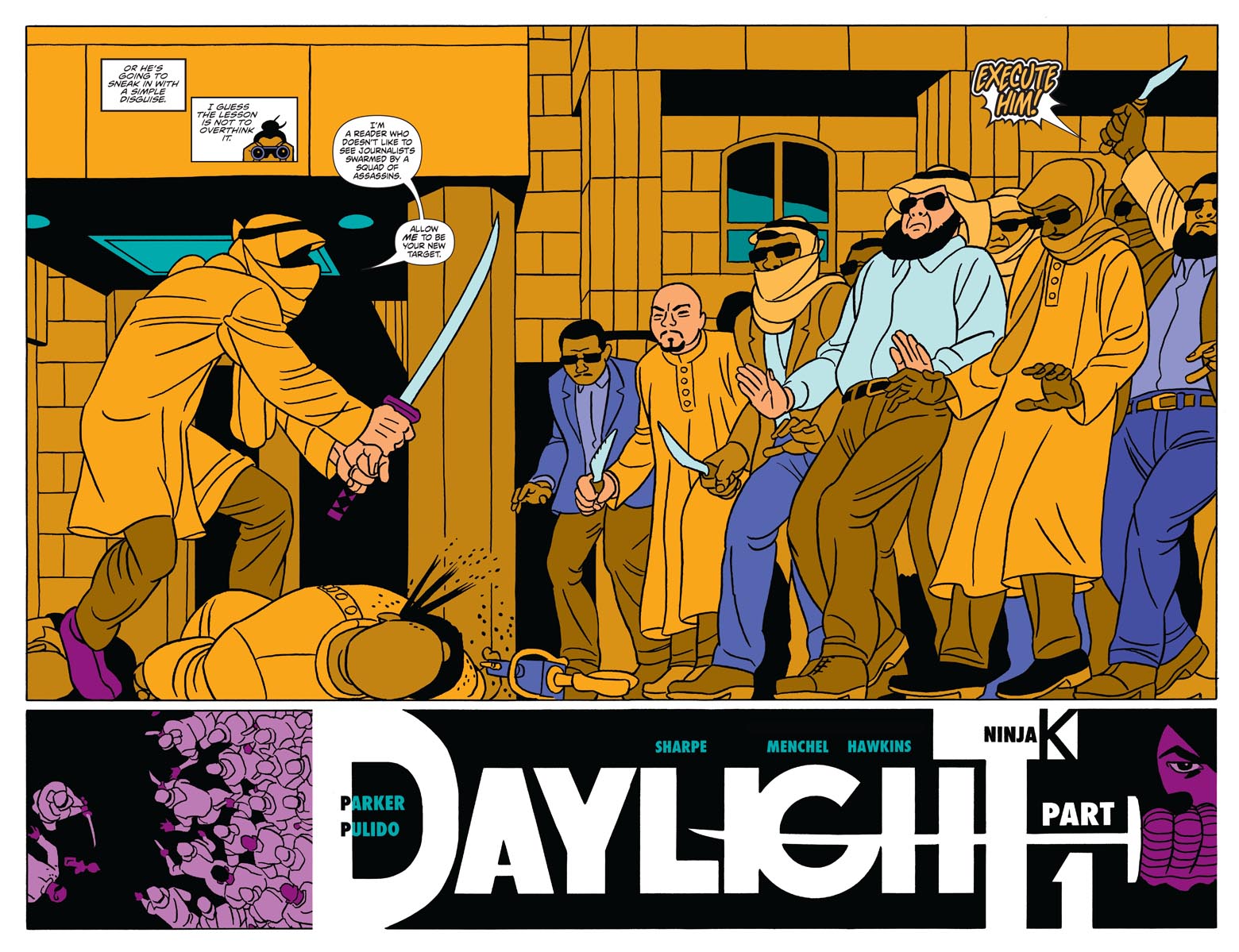Ninjak #1 and how Javier Pulido reminds us how bold and daring comics can be
An inside look on the upcoming Valiant series Ninjak by Jeff Parker and Javier Pulido

Javier Pulido is redefining Valiant Entertainment's Ninjak in the new series with co-creator Jeff Parker - but they're not taking away or adding anything to sleuthy spy character. As the artist tells Newsarama, they're "re-creating" the character in a way that anyone and everyone - Ninjak devotee or not - can understand and appreciate.

Debuting July 14, Parker and Pulido's Ninjak #1 finds super-spy Colin King in a situation his type would abhor - a man who prides himself on discovering and exploiting secrets must now react when all of his own secrets have been exposed to the world.
Pulido has made a name for himself with clean lines and pop-culture sensibilities, and with Ninjak #1 he's taking that to the next logical step by coloring his own work. But now as he has full control over the art, the colors are less an afterthought after the linework is finished but instead an integral part he can coordinate - and in essence, choreograph - to create a holistic comic book experience.
In other words, a bold, engaging and thrilling comic book.
For more on the new series, we talked with Pulido.
Newsarama: Javier, I'm engrossed by what you're doing here with Ninjak - you're really going into some bold, assured choices with your line-work where every bit counts. This seems like a continuation of your last major interiors work, She-Hulk, but much further along. Where do these choices to go this boldly come from?
Javier Pulido: Thanks, very glad you're enjoying the book so far.
Get the best comic news, insights, opinions, analysis and more!

About the work choices I do, I think that you nailed it yourself. When telling a story, every bit counts. I'd add that it is not only everything in the comic that counts, what has been left out are, at least, equally important. So it's not as much about making bold choices as it is about knowing the story you're telling, and finding the more direct way to put it on the page.
It's been years since She-Hulk, but I essentially approach work the same way. It's only they're different stories, and characters. I think the differences you appreciate may be mostly a matter of line-work, which is a choice, and also color.
Nrama: You're doing your own colors here, the first time for interior work.
Pulido: I used to be very involved in the coloring process, but this time I'm doing it all, I think that puts a different light over a drawing, which at the end is the face of the work.
Nrama: You and Jeff worked together briefly once before, but this is your first time working at length. And I noticed for the credits you and he share co-creator credit instead of just a strict like of writer and artist. What is this collaboration like, and are you able to make some bigger decisions about storytelling and panel breakdowns here?
Pulido: Well, to start, the writer/artist division is unreal, if telling stories is what we are talking about. Same with taking art and story as if they were different things. This is comics, a visual medium, art is story.

To not expand too much, what I essentially do is rewriting the story, but visually, which is the way comics work. The script is a way to the story. Once found, it is the story that asks for what it needs. Layout, drawing style, color, are just the surface of what is a global storytelling process.
Maybe I'm being vague, it'd probably take a page or scene's analysis to really start to see the nuts and bolts of the job. Anyway, this is not new, I've been working this way for many years now.
The co-credit you refer to is meant to indicate that this book is not done in the way people are used to expecting, at the least. I proposed it to Jeff, and he agreed. He could have passed, and take the whole storytelling merit, as many times happens. Nonetheless, I don't fool myself, very few readers will be as picky on it as you were, Chris.
Nrama: I love the craft of it.

Pulido: I'd want to add that, beyond credits, Jeff's support it's being key in the making of the book. I could hardly work this way not having him here. I like to think he understands that my choices are always about the story.
Nrama: After reading an advance copy of Ninjak #1, I retrieved my old copies of Human Target to try to chase the good feelings. I have a real fondness for your Human Target - how do you feel about it years later?
Pulido: That book had not many readers, but I guess some selected ones. Sometimes I think that it was not the right time for it.
Well, I keep being fond of the book. In some cases, it's not about the work itself, but about the kind of choices I made to put the story on paper.
Peter Milligan's scripts were pretty demanding, because of the ideas, and also technically, the way he approached scriptwriting. The graphic novel was, by far, the most demanding stuff I had ever worked on, several weeks until pencil met paper.

Then the series, which was planned as story-arcs of, basically, independent stories. Because of the nature of both characters and this 'series of miniseries' structure, I chose to take a totally different approach to the storytelling on every story, every time. Structure, drawing style, layout, color. It was a killer amount of work, the kind that is mostly invisible to readers, but really gives direction to the story.
Looking at it now, I can see that the kind of choices that brought me to the Human Target book are the kind that has defined me as a creator, and have shaped my career.
Nrama: What do you think about returning to the espionage genre with Ninjak? I imagine this genre lends itself to much different storytelling choices and coloring than superheroes.
Pulido: I don't think about the material from a genre POV, it's all about story and character. If something, it'd be the opposite. When making a comic I try to think of readers that are virgin to that kind of thing, or even to the medium.

About the choices themselves, this is comic storytelling, it works on every case.
Nrama: Although Ninjak could be called a superhero, in this first issue you keep scenes of him in that full superhero-ish costume to a minimum, and your character work with Colin and everyone else really have room to grow as a real spy comic, superhero, or not. Do you enjoy drawing comics where they don't have those kinds of immediately identifiable superhero costumes, but you can draw real people and real clothes?
Pulido: That's character. Ninjak is, above all, elusive. You won't notice him until it's too late. His introduction scene, on issue #1, is a good example of this.
More than having drawing preferences, I enjoy the process of finding the way of bringing the story to the page. In issue #2, for example, we have a long fight scene that is more 'superheroic' than anything you saw in issue #1, and I really enjoyed that one.
Nrama: I look forward to that.

This first issue of Ninjak is a really inspiring piece of work, Javier. What would you say your inspirations were in drawing it so far?
Pulido: Thanks again, really appreciate it.
Don't know if the word 'inspiration' fits, but the way Jeff writes, which in short I'd define as 'he writes for comics', really allows me to make use of my storytelling muscles. Other than that, I keep as interested in making comics as on day one. So, the medium itself is an inspiration, definitively.
Nrama: What do you want to tell your fans about this new run on Ninjak, and these changes you've made with your art?
Pulido: If such a thing exists, they might enjoy this book. I think it makes for an enjoyable read, at the least, and they don't really have to know anything about the character to understand what's happening, Jeff's been very clever about that. In a way, it's like we're re-creating the character.
Ninjak #1 goes on sale on July 14, both in print and on digital platforms. For the best digital experience, consult our guide to the best digital comics readers for Android and iOS devices.
Chris Arrant covered comic book news for Newsarama from 2003 to 2022 (and as editor/senior editor from 2015 to 2022) and has also written for USA Today, Life, Entertainment Weekly, Publisher's Weekly, Marvel Entertainment, TOKYOPOP, AdHouse Books, Cartoon Brew, Bleeding Cool, Comic Shop News, and CBR. He is the author of the book Modern: Masters Cliff Chiang, co-authored Art of Spider-Man Classic, and contributed to Dark Horse/Bedside Press' anthology Pros and (Comic) Cons. He has acted as a judge for the Will Eisner Comic Industry Awards, the Harvey Awards, and the Stan Lee Awards. Chris is a member of the American Library Association's Graphic Novel & Comics Round Table. (He/him)



